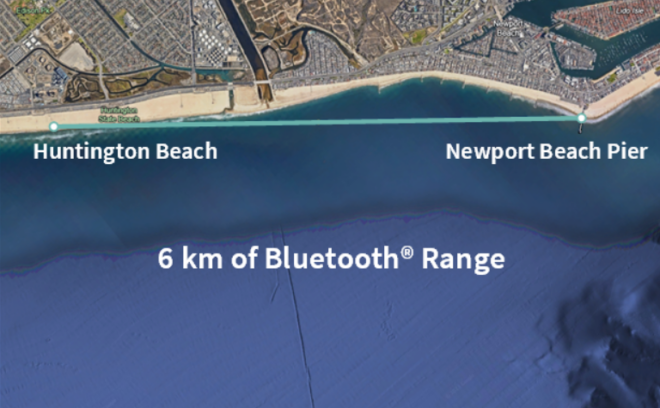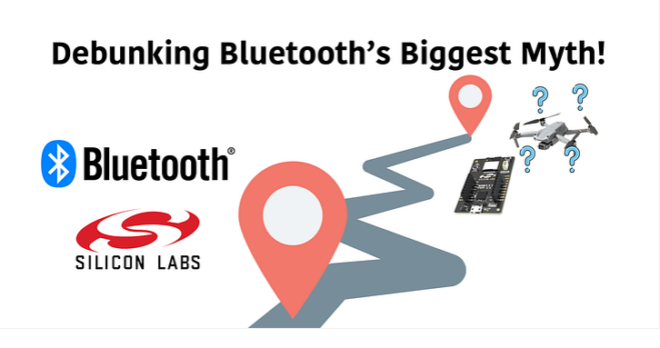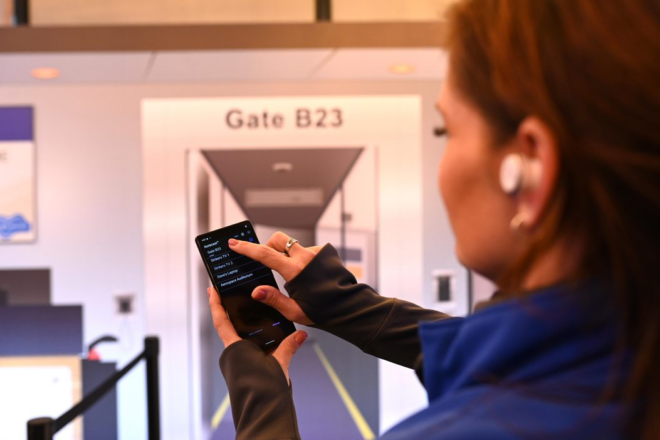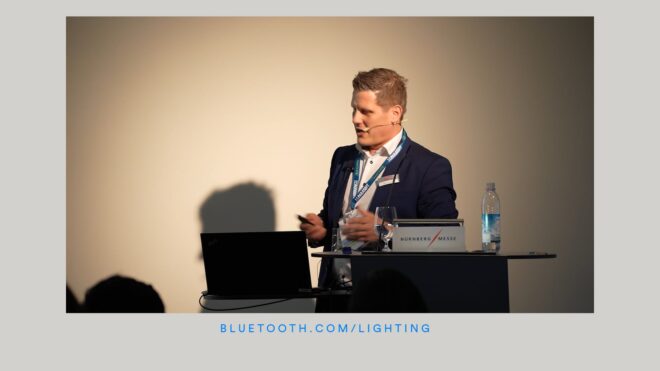Bluetooth® 5 is here and it’s a major step up from the current standard for wireless connectivity, Bluetooth v4.2, with its 4-times longer range, 2-times higher speed, plus 8-times larger advertisement packet length for the data. Developer can visit the Bluetooth SIG website and download the latest Bluetooth core spec here.
Right after Bluetooth 5 released, a developer asked me: with Bluetooth 5 higher bandwidth feature, how fast can it be? Today, we will have an inside look on Bluetooth low energy data throughput in theory when a connection is established, not only for Bluetooth 5, but also previous versions of Bluetooth low energy as well.
As we know, for wireless connectivity, there is some transmission cost for link maintenance and packet redundancy to keep the Bluetooth connection robust and efficient. For Bluetooth LE connection, one complete transmission period from one device to its peer device is like this:

Figure 1
- “T” slot is the transmission packet; it includes the frame header, payload and integrity check field, and the useful data would be located in the payload to transmit.
- “R” slot is the receive packet from peer device; when the device transmits one packet to a peer device, the peer device would send back a packet which has a minimum packet length to indicate previous transmission is successful.
- “T_IFS” is the inter frame space; it defines the time interval between two consecutive packets. “T_IFS” should be 150 µs no matter if you are using Bluetooth 5 or Bluetooth 4.0. As for detail about “T_IFS”, please refer to Vol 6, Part B, Section 4.1 no matter in Bluetooth 5 core spec or Bluetooth v4.0, v4.1 and v4.2.
So, the formula for Bluetooth low energy data throughput for a connection would be:

Using this formula, we will calculate data throughput from 4.0 to 5 when a connection is established.
Bluetooth v4.0/4.1
Bluetooth® v4.0/4.1 have same low energy packet format and same modulation rate, 1Mb/s, which means the transmitter has the capability to transmit one megabit in one second.
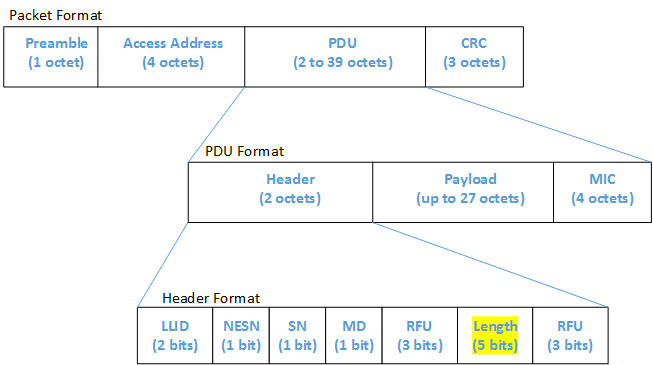
Figure 2
Figure 2 represents the packet format, PDU format, and header format of 4.0/4.1 link layer data packet. From figure 2, the length field is 5-bits in length (which is already highlighted; 5 bits is equal to 0b11111 for binary, 0x1F for hexadecimal, 31 for decimal) and it has the range of 0 to 31 octets which indicates the length of the Payload and MIC if included. The Payload field shall be less than or equal to 27 octets in length because the MIC is 4 octets in length, 31 – 4 = 27.
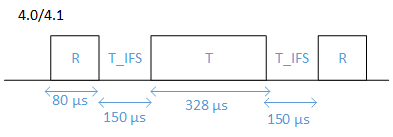
Figure 3
Figure 3 is one complete period diagram. From figure 3, the time of one complete period includes:
- “R” slot
The empty PDU length is: 10 octets because:
|
Preamble |
Access Address |
Header |
CRC |
|
1 |
4 |
2 |
3 |
The length of empty PDU = 1 + 4 + 2 + 3 = 10 octets.
It will consume 80 µs by 1Mb/s because:
![]()
- T_IFS, 150 m
- “T” slot
The maximum data packet length is:
|
Preamble |
Access Address |
Header |
Payload |
MIC |
CRC |
|
1 |
4 |
2 |
27 |
4 |
3 |
1 + 4 + 2 + 27 + 4 + 3 = 41 octets
It will consume 328 µs because:
![]()
For 4.0/4.1 throughput, the calculation is:

Bluetooth v4.2
For Bluetooth® v4.2, the modulation rate is the same with 4.0 and 4.1, it’s still 1Mb/s. but the packet format is different. The difference is in below diagram, figure 4.
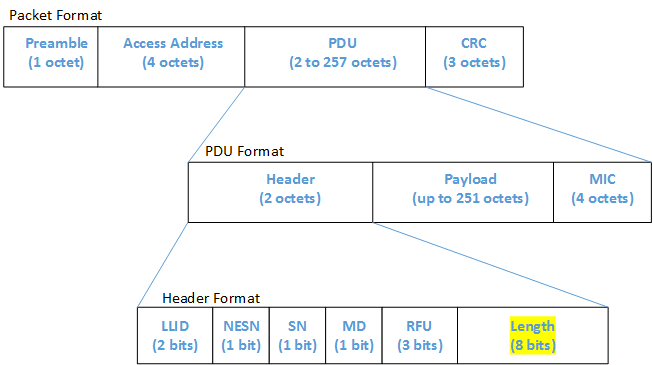
Figure 4
From figure 4, the length field is 8-bits in length (which is already highlighted, 8 bits equal to 0b11111111 for binary, 0xFF for hexadecimal, 255 for decimal) and it has the range of 0 to 255 octets which indicates the length of the Payload and MIC if included. The Payload field shall be less than or equal to 251 octets in length because the MIC is 4 octets in length, 255 – 4 = 251.
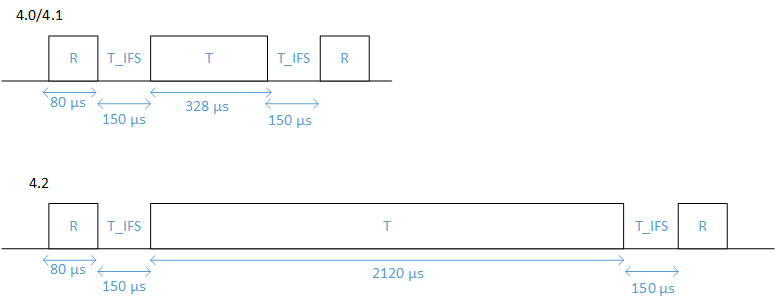
Figure 5
Figure 5 is one complete period diagram, from figure 5, the time of one complete period includes:
- “R” slot
It’s the same with v4.0/4.1, 80 µs.
- T_IFS, 150 m
- “T” slot
The maximum data packet length is:
|
Preamble |
Access Address |
Header |
Payload |
MIC |
CRC |
|
1 |
4 |
2 |
251 |
4 |
3 |
1 + 4 + 2 + 251 + 4 + 3 = 265 octets
It will consume 2120 µs because:

For 4.2 throughput, the calculation is:

Bluetooth 5
For Bluetooth® 5, the modulation rate has two options. The first is 1Mb/s like Bluetooth v4.0/4.1/4.2; the second is what we will discuss next, 2Mb/s. The packet format from Bluetooth v4.2 to Bluetooth 5 is the same: payload is 251 octets. So the data throughput of Bluetooth 5 @1Mb/s would be the same with Bluetooth 4.2.
But after enabling 2Mb/s, it is different. You can see this in figure 6.
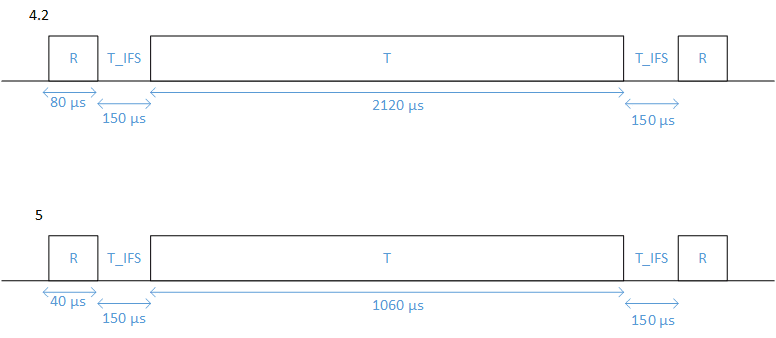
Figure 6
Figure 6 is one complete period diagram. From figure 6, the time of one complete period includes:
- “R” slot
The length of empty PDU is 10 octets:
|
Preamble |
Access Address |
Header |
CRC |
|
1 |
4 |
2 |
3 |
The length of empty PDU = 1 + 4 + 2 + 3 = 10 octets.
It will consume 40 µs by 2Mb/s because:
![]()
- T_IFS, 150 m
- “T” slot
The maximum data packet length is:
|
Preamble |
Access Address |
Header |
Payload |
MIC |
CRC |
|
1 |
4 |
2 |
251 |
4 |
3 |
1 + 4 + 2 + 251 + 4 + 3 = 265 octets
It will consume 1060 µs because:

For Bluetooth 5 throughput, the calculation is:

Conclusion
For Bluetooth® low energy throughput in theory, the chart below illustrates the differences between the Bluetooth low energy specifications. You can see that Bluetooth 5 has a bandwidth that is ~4.6-times greater than 4.0/4.1 and ~1.7-times greater than 4.2. Higher bandwidths can translate into higher speeds, and this will allow Bluetooth low energy to transmit data streams faster than ever before – more efficient, less band occupation, and more suitable for rapid data transmission. For application scenarios like Over-The-Air firmware upgrades, or wearable device data log synchronization, Bluetooth 5 will enable brilliant user experiences, while higher speeds will build a solid platform for future high data rate stream transmissions.
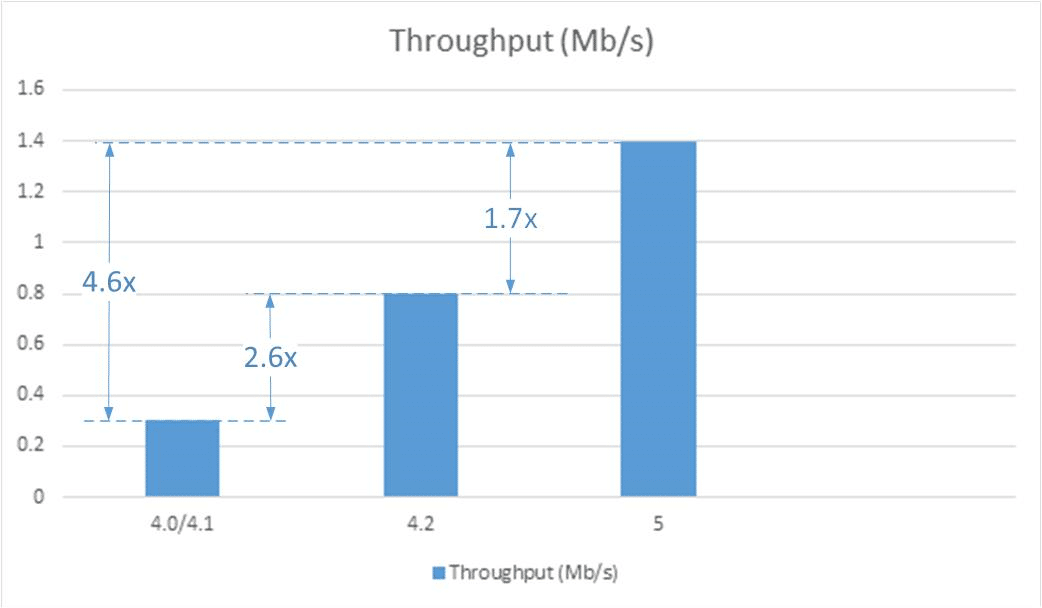
![]()
FEATURED DOWNLOAD
Bluetooth 5: Go Faster, Go Further
Download this comprehensive overview to discover how Bluetooth 5 significantly increases the range, speed, and broadcast messaging capacity of Bluetooth applications, making use cases in smart home automation, enterprise, and industrial markets a reality.





